
The Piper PA-38-112 Tomahawk is a two-seat, fixed tricycle gear general aviation airplane, originally designed for flight training, touring and personal use.

The Standard Cirrus is a Standard-class glider built in Germany by Schempp-Hirth. The Standard Cirrus was produced between 1969 and 1985, when it was replaced by the Discus. Over 800 examples were built, making it one of the most successful early fibreglass glider designs.
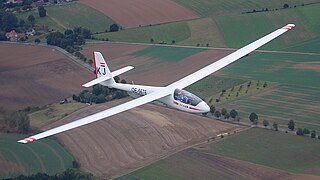
The Schleicher ASW 15 is a single-seat sailplane designed in 1968 by Gerhard Waibel and manufactured by Alexander Schleicher GmbH & Co. The ASW 15 has shoulder-mounted wings and an all-flying tailplane, with its single tow-release placement a compromise between winching and aerotowing. The later ASW 15B had several improvements, including a tow-release placed on the plane of symmetry, an 11 cm taller rudder, a slightly larger main wheel, and the provision of a 90-litre water ballast system.
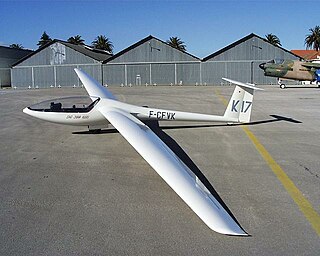
The Glaser-Dirks DG-300 is a Standard Class single-seat high-performance glider built from glass-reinforced plastic. The DG-300 was designed by Wilhelm Dirks and manufactured by Glaser-Dirks Flugzeugbau's Slovenian partner company Elan (company). A total of 511 of all versions were built since production started in 1983. Representative contemporary types from competing manufacturers are the Rolladen-Schneider LS4 and the Schempp-Hirth Discus.

The PZL Bielsko SZD-50 Puchacz is a Polish two-place training and aerobatic sailplane.

The Grob G 120 is a two-seat training and aerobatic low-wing aircraft with a carbon composite airframe, built by Grob Aircraft. It is based on the Grob G 115TA training aircraft and is specially designed for military and civil pilots training. It has a tricycle landing gear and a low tailplane.

The G102 Astir is a single-seat glassfibre Club Class sailplane, designed by Burkhart Grob and built by Grob Aircraft. It was the first Grob-designed sailplane, with the first flight in December 1974. Grob had previously built the Schempp-Hirth Standard Cirrus under licence.

The Grob G109 is a light aircraft developed by Grob Aircraft AG of Mindelheim Mattsies in Germany. It first flew in 1980. The G109B followed in 1984. It is a two-seat self-launching motor glider in which the pilot and passenger or student sit side by side, with good visibility provided by large windows.

The G103 Twin II is a high-performance two-seat sailplane manufactured in Germany by Grob Aircraft. The aircraft is of T-tail configuration, and is fitted with upper-surface airbrakes and a non-retractable undercarriage. Of fiberglass construction, it is designed for training, high performance cross-country racing and simple aerobatic flying.

The Yakovlev Yak-50 aerobatic aircraft is a single-seat all-metal low-wing monoplane with retractable main wheels and exposed tail wheel. The control surfaces are fabric-covered to save weight. The aircraft is not equipped with flaps.
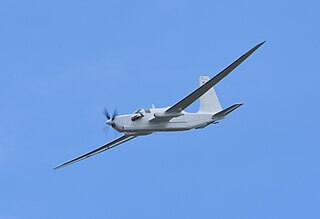
The Grob G 520 is a turboprop long-endurance, high-altitude reconnaissance and surveillance aircraft built by Grob Aircraft with short runway capabilities and full approval for all-weather IFR/icing operations according to LBA/FAA Part 23 regulations. Developed and certified in 1991, the Grob G 520 is one of the world's largest fully composite manned aircraft and holder of several world records. Production was resumed in 2014.
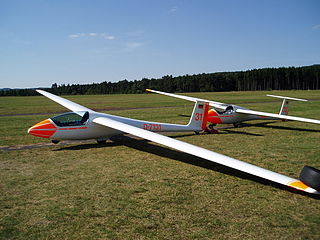
The Schleicher ASK 23 is a single-seat Club Class sailplane that was built by the German manufacturer Alexander Schleicher GmbH & Co.

The Grob G104 Speed Astir was a competition sailplane produced in Germany in the late 1970s as Grob's first design in the 15 metre class.

The Grob G 103 Twin Astir is a glass-reinforced plastic two-seat sailplane that was developed in Germany in the 1970s by Grob Aircraft AG as a counterpart to the single-seat G 102 Astir, then in production. Construction throughout is similar, although to preserve the centre of gravity of the design, the wings were given a slight forward sweep. While many two-seat derivatives of single-seat sailplanes have fixed undercarriage, due to the added space restrictions created by the second seat, Grob devised a novel retraction system for the Twin Astir. The single wheel was designed to rotate 90° sideways before retracting "flat" under the rear seat, resulting in a rather unusual seating position. This was only incorporated in early examples, later on, the wheel was fixed. Factory options offered to customers included whether the front seat should be equipped with flight instruments, and whether water ballast capacity should be installed.

The ICA IS-28 is a two-seat sailplane produced in Romania in the 1970s. An all-metal aircraft of conventional design with a T-tail, it was originally produced with 15-metre wings, but in 1973, production shifted to the IS-28B with 17-metre wings and numerous aerodynamic refinements. These included a smaller tail with decreased dihedral, decreased dihedral on the wings, and redesigned fuselage contours. This version first flew on 26 April 1973 and was subsequently produced in versions with flaps (IS-28B2) and without (IS-28B1). Around 100 had been built by the early 1980s, with a substantial number sold for export. On April 7, 1979, Tom Knauff and R. Tawse set a world record with the IS-28 B2 glider, covering a distance of 829 kilometres on a predetermined out-and-return course from the Ridge Soaring Gliderport in Julian, Pennsylvania.

The Grob G103 is a family of glass-reinforced plastic two-seat sailplanes developed in Germany by Grob Aircraft AG. The aircraft are of T-tail configuration and fitted with upper surface air brakes. They are designed for training, high performance soaring and basic aerobatic flying.

The SZD-59 Acro is a single-seat glass composite glider for aerobatics and cross-country flying by PZL Allstar of Bielsko-Biała, Poland.

The Slingsby T.30 Prefect is a 1948 British modernisation of the 1932 single-seat Grunau Baby glider. About 53 were built for civil and military training purposes.
The Seahawk Condor is an American ultralight aircraft that was designed by Buddy Head, Bob Carswell and Dave French and produced by Seahawk Industries and later by Condor Aircraft. The aircraft was supplied as a kit for amateur construction.
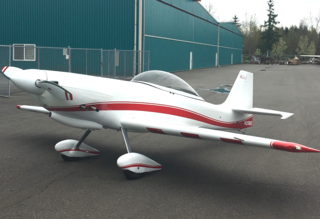
The Aircraft Technologies Acro 1 is an American aerobatic homebuilt aircraft that was designed by Fred Meyer and produced by Aircraft Technologies of Lilburn, Georgia. When it was available the aircraft was supplied as a kit or in the form of plans for amateur construction. Neither plans nor kits are available anymore and the aircraft is out of production.


















